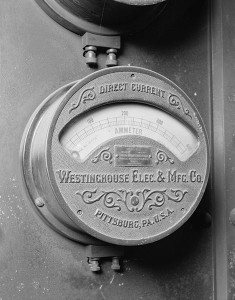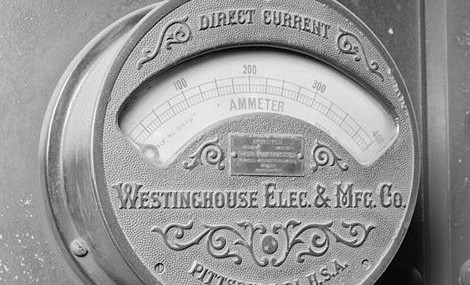 An ammeter is an instrument that measures the current in an electric circuit. The principle that governs the operation of the ammeter was discovered in 1820 by the Danish physicist Hans Christian Oersted, who found that a compass needle is deflected when it is placed near a current-carrying conductor. In 1882, Jacques Arsene d’Arsonval of France devised a moving-coil, permanent-magnet galvanometer similar to the ammeter now most commonly in use.
An ammeter is an instrument that measures the current in an electric circuit. The principle that governs the operation of the ammeter was discovered in 1820 by the Danish physicist Hans Christian Oersted, who found that a compass needle is deflected when it is placed near a current-carrying conductor. In 1882, Jacques Arsene d’Arsonval of France devised a moving-coil, permanent-magnet galvanometer similar to the ammeter now most commonly in use.
The moving-coil ammeter consists of a horseshoe-shaped permanent magnet, a moving coil, hairsprings, a pointer, and a scale. The movable coil of fine wire is suspended in a cylindrical air gap between the permanent-magnet poles.
This lightweight coil is pivoted on bearings so that only a small force is required to rotate it. The hairsprings, which are attached to the coil structure, establish the static, no-current position of the coil. The pointer, which is attached to the coil, moves over a calibrated scale to display the meter reading in units of amperes.
Direct current (d-c) passing through the coil produces a magnetic field that interacts with the permanent-magnet field. This interaction produces a torque that drives the coil against the hairsprings. The pointer stabilizes when the magnetic force is balanced by the spring force.
In most ammeters the pointer deflection is directly proportional to the coil current. For measuring alternating current (a-c), moving-coil ammeters have a rectifier that converts a-c to d-c. Many commercial ammeters are designed for both a-c and d-c measurements.
An ammeter can measure a wide range of currents because it has a device that allows only a portion of the current to pass through the coil. In d-c ammeters a shunt is used for this function; a-c ammeters use a current transformer.
Besides the moving-coil ammeter, there are moving-vane, electrodynamometer, and hot-wire types of ammeters. These types are used mainly for a-c measurements. Where a-c measurements must be made and it is not practical to open the circuit, clamp-on ammeters are used.
Technicians use ammeters to measure the current drain of household appliances to determine that the capacity of house lines is adequate and to troubleshoot household appliances.
[phpzon keywords=”ammeter” num=”4″ country=”US” searchindex=”Tools” trackingid=”diy-do-it-yourself-20″ sort=”none” templatename=”default” paging=”true”]










